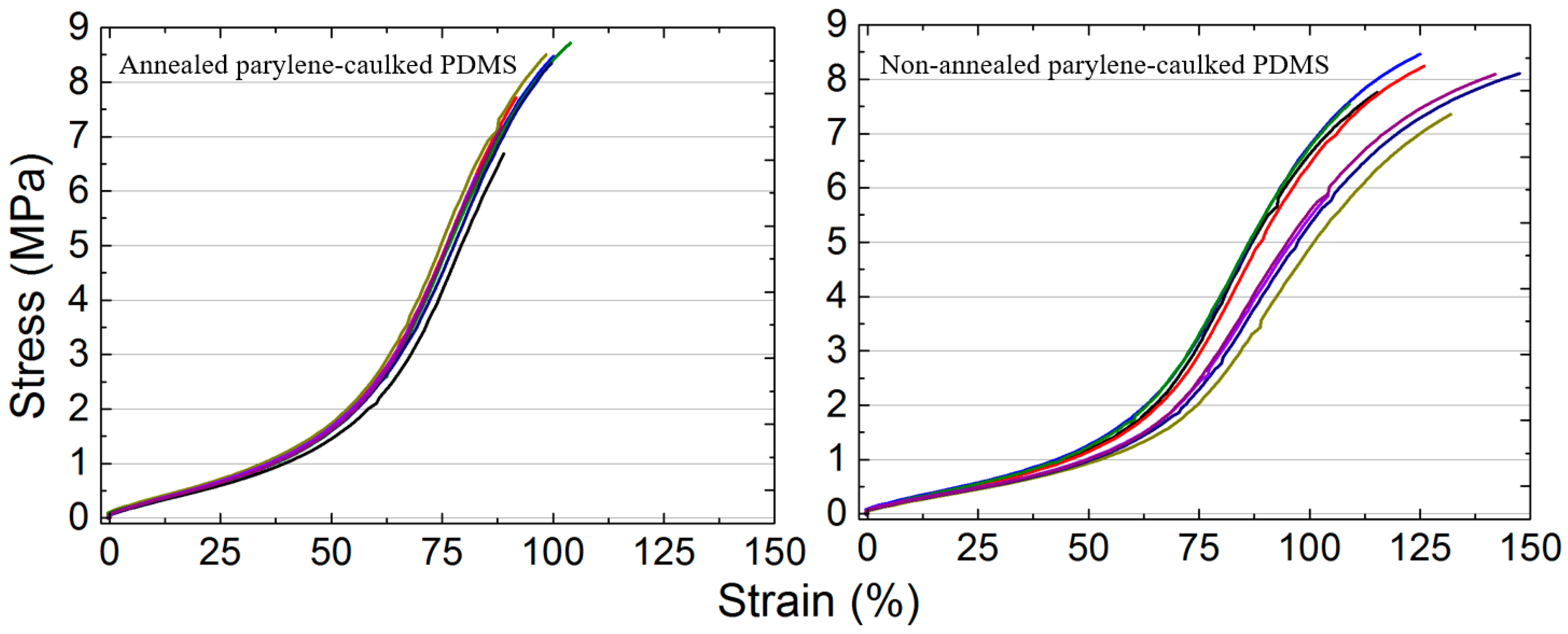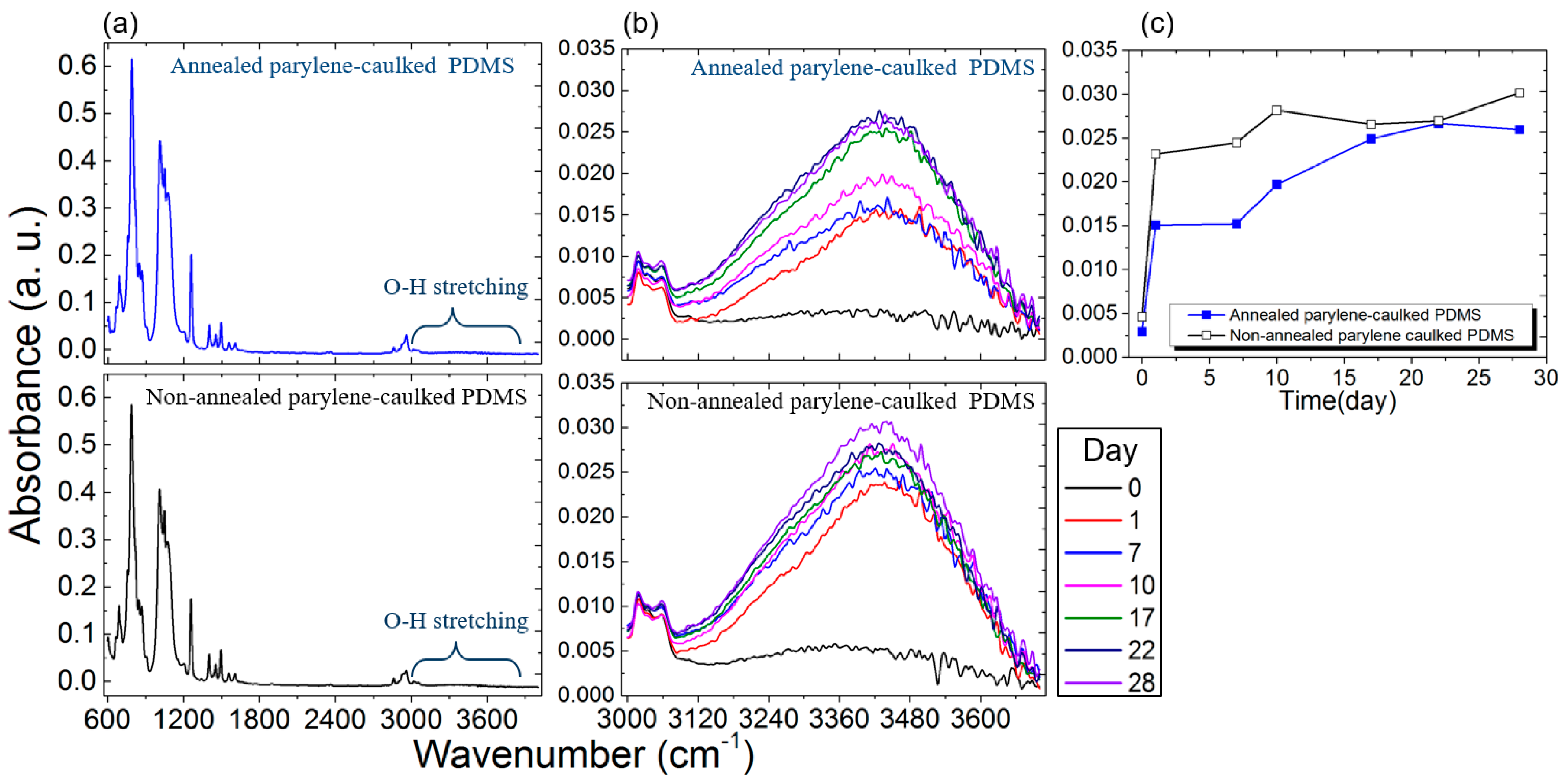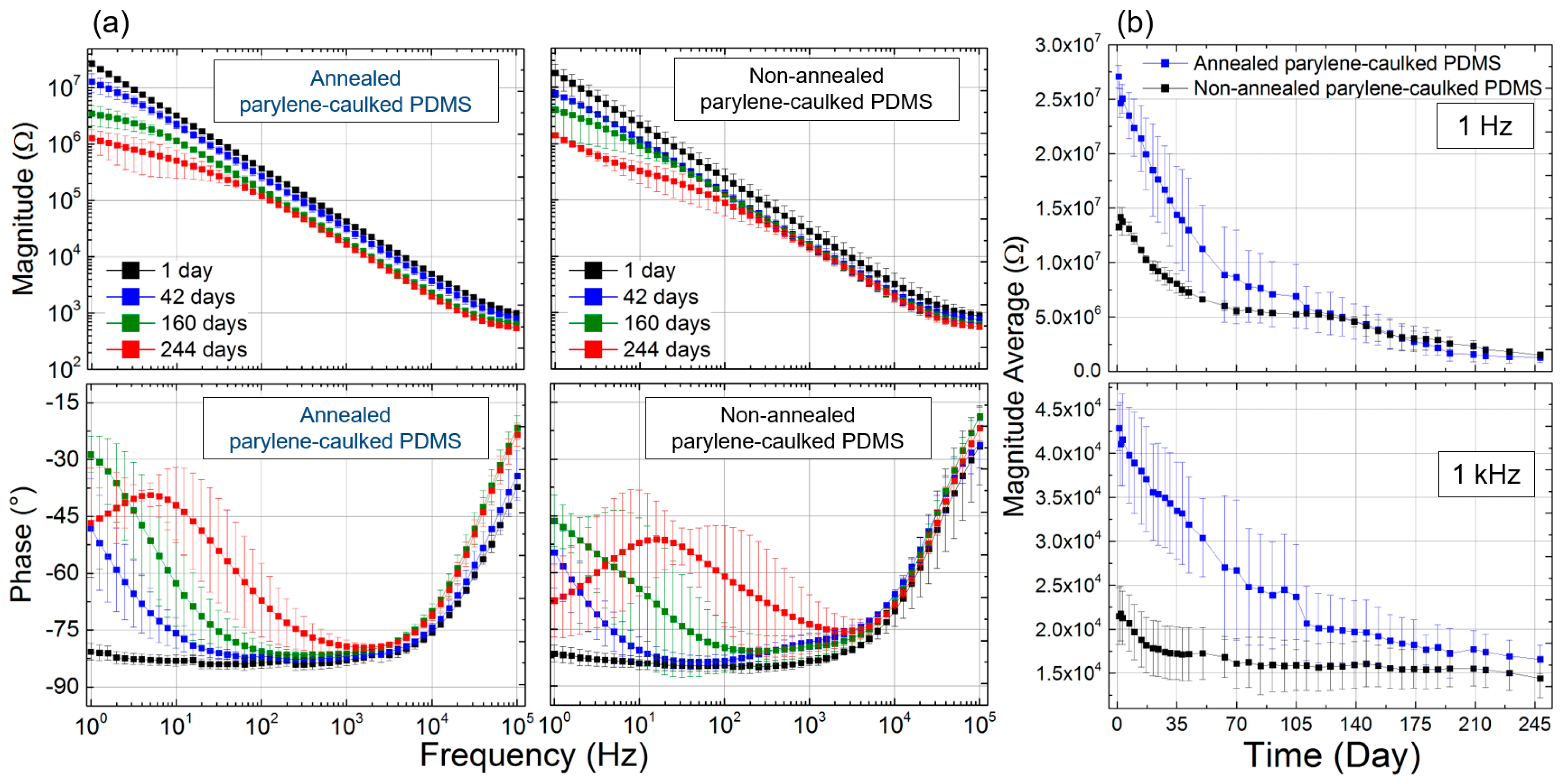Annealing Effects of Parylene-Caulked Polydimethylsiloxane as a Substrate of Electrodes
Abstract
:1. Introduction
2. Materials and Methods
2.1. Preparation of pc-PDMS Substrate
2.2. Tensile Test
2.3. Fourier Transform Infrared Spectroscopy (FTIR)
2.4. Electrode Fabrication Based on pc-PDMS
2.5. Impedance Characterization
3. Results
3.1. Mechanical Characterization
3.2. Water Absorption Property
3.3. Impedance Characterization
4. Conclusions
Acknowledgments
Author Contributions
Conflicts of Interest
References
- Hsu, J.M.; Rieth, L.; Normann, R.A.; Tathireddy, P.; Solzbacher, F. Encapsulation of an integrated neural interface device with parylene C. IEEE Trans. Biomed. Eng. 2009, 56, 23–29. [Google Scholar] [PubMed]
- Mercanzini, A.; Cheung, K.; Buhl, D.L.; Boers, M.; Maillard, A.; Colin, P.; Bensadoun, J.C.; Bertsch, A.; Renaud, P. Demonstration of cortical recording using novel flexible polymer neural probes. Sens. Actuators A Phys. 2008, 143, 90–96. [Google Scholar] [CrossRef]
- Chou, N.; Yoo, S.; Kim, S. A largely deformable surface type neural electrode array based on PDMS. IEEE Trans. Neural Syst. Rehabil. Eng. 2013, 21, 544–553. [Google Scholar] [CrossRef] [PubMed]
- Chun, W.; Chou, N.; Cho, S.; Yang, S.; Kim, S. Evaluation of sub-micrometer parylene C films as an insulation layer using electrochemical impedance spectroscopy. Prog. Org. Coat. 2014, 77, 537–547. [Google Scholar] [CrossRef]
- Cho, S.; Nam, T.; Byun, D.; Choi, S.; Kim, M.; Kim, S. Zebrafish needle EMG: A new tool for high-throughput drug screens. J. Neurophysiol. 2015, 114, 2065–2070. [Google Scholar] [CrossRef] [PubMed]
- Negi, S.; Bhandari, R.; Rieth, L.; Solzbacher, F. In vitro comparison of sputtered iridium oxide and platinum-coated neural implantable microelectrode arrays. Biomed. Mater. 2010, 5, 015007. [Google Scholar] [CrossRef] [PubMed]
- Kuo, J.T.W.; Kim, B.J.; Hara, S.A.; Lee, C.D.; Gutierrez, C.A.; Hoang, T.Q.; Meng, E. Novel flexible Parylene neural probe with 3D sheath structure for enhancing tissue integration. Lab Chip 2013, 13, 554–561. [Google Scholar] [CrossRef] [PubMed]
- Grosser, M.; Schmid, U. The impact of annealing temperature and time on the electrical performance of Ti/Pt thin films. Appl. Surf. Sci. 2010, 256, 4564–4569. [Google Scholar] [CrossRef]
- Matko, V.; Donlagic, D. Sensor for high-air-humidity measurement. IEEE Trans. Instrum. Meas. 1996, 45, 561–563. [Google Scholar] [CrossRef]
- Matko, V. Next Generation AT-Cut Quartz Crystal Sensing Devices. Sensors 2011, 11, 4474–4482. [Google Scholar] [CrossRef] [PubMed]
- Adegbuyi, P.A.O.; Atiri, A.; Sc, B. The Effect of Annealing on the Microstructure of Mechanical Properties of a Rolled Steel Product. Pac. J. Sci. Technol. 2009, 10, 149–162. [Google Scholar]
- Kang, X.; Liu, J.Q.; Tian, H.; Yang, B.; Nuli, Y.; Yang, C. Self-Closed Parylene Cuff Electrode for Peripheral Nerve Recording. J. Microelectromech. Syst. 2015, 24, 319–332. [Google Scholar] [CrossRef]
- Jeong, J.; Chou, N.; Kim, S. Fabrication of flexible electrode array based on PDMS for long-term in-vivo use. In Proceedings of the 2013 6th International IEEE/EMBS Conference on Neural Engineering (NER), San Diego, CA, USA, 6–8 November 2013; pp. 911–914.
- Lei, Y.; Liu, Y.; Wang, W.; Wu, W.; Li, Z. Studies on Parylene C-caulked PDMS (pcPDMS) for low permeability required microfluidics applications. Lab Chip 2011, 11, 1385–1388. [Google Scholar] [CrossRef] [PubMed]
- Jeong, J.; Chou, N.; Kim, S. Long-term characterization of neural electrodes based on parylene-caulked polydimethylsiloxane substrate. Biomed. Microdevices 2016, 18. [Google Scholar] [CrossRef] [PubMed]
- Gregory, T.R.; Tyler, H.; Kevin, J.B.; Todd, G.S.; Culbertson, C.T. Sol−Gel Modified Poly(dimethylsiloxane) Microfluidic Devices with High Electroosmotic Mobilities and Hydrophilic Channel Wall Characteristics. Anal. Chem. 2005, 77, 1414–1422. [Google Scholar]
- Chou, N.; Jeong, J.; Kim, S. Crack-free and reliable lithographical patterning methods on PDMS substrate. J. Micromech. Microeng. 2013, 23, 125035. [Google Scholar] [CrossRef]
- Mukhopadhyay, R. When PDMS isn’t the best. Anal. Chem. 2007, 79, 3248–3253. [Google Scholar] [CrossRef] [PubMed]
- Favre, E.; Schaetzel, P.; Nguygen, Q.T.; Clément, R.; Néel, J. Sorption, diffusion and vapor permeation of various penetrants through dense poly(dimethylsiloxane) membranes: A transport analysis. J. Membr. Sci. 1994, 92, 169–184. [Google Scholar] [CrossRef]
- Kuo, J.T.W.; Kim, B.J.; Hara, S.A.; Lee, C.D.; Yu, L.; Gutierrez, C.A.; Hoang, T.Q.; Pikov, V.; Meng, E. 3D Parylene sheath probes for reliable, long-term neuroprosthetic recordings. In Proceedings of the 2013 IEEE 26th International Conference on Micro Electro Mechanical Systems (MEMS), Taipei, Taiwan, 20–24 January 2013; Volume 45002, pp. 1073–1076.
- Von Metzen, R.P.; Stieglitz, T. The effects of annealing on mechanical, chemical, and physical properties and structural stability of Parylene C. Biomed. Microdevices 2013, 15, 727–735. [Google Scholar] [CrossRef] [PubMed]
- ASTM D412-06a, Standard Test Methods for Vulcaizaed Rubber and Thermoplastic Elastomers-Tension. 2012. Available online: www.astm.org (accessed on 19 September 2012).
- Davis, E.M.; Benetatos, N.M.; Regnault, W.F.; Winey, K.I.; Elabd, Y.A. The influence of thermal history on structure and water transport in Parylene C coatings. Polymer 2011, 52, 5378–5386. [Google Scholar] [CrossRef]
- Ludvigsson, M.; Lindgren, J.; Tegenfeldt, J. FTIR study of water in cast Nafion films. Electrochim. Acta 2000, 45, 2267–2271. [Google Scholar] [CrossRef]
- Baker, M.J.; Trevisan, J.; Bassan, P.; Bhargava, R.; Butler, H.J.; Dorling, K.M.; Fielden, P.R.; Fogarty, S.W.; Fullwood, N.J.; Heys, K.A.; et al. Using Fourier transform IR spectroscopy to analyze biological materials. Nat. Protoc. 2014, 9, 1771–1791. [Google Scholar] [CrossRef] [PubMed] [Green Version]
- Vasenkov, A.V. Atomistic modeling of parylene-metal interactions for surface micro-structuring. J. Mol. Model. 2011, 17, 3219–3228. [Google Scholar] [CrossRef] [PubMed]
- Wu, P.K.; Yang, G.R.; McDonald, J.F.; Lu, T.M. Surface reaction and stability of parylene-N and parylene-F thin films at elevated temperatures. J. Electron. Mater. 1995, 24, 53–58. [Google Scholar] [CrossRef]
- Harrison, R.R. A Versatile Integrated Circuit for the Acquisition of Biopotentials. In Proceedings of the 2007 IEEE Custom Integrated Circuits Conference, San Jose, CA, USA, 16–19 September 2007; pp. 115–122.
- Grosse, P. EEG–EMG, MEG–EMG and EMG–EMG frequency analysis: Physiological principles and clinical applications. Clin. Neurophysiol. 2002, 113, 1523–1531. [Google Scholar] [CrossRef]
- Johnston, I.D.; McCluskey, D.K.; Tan, C.K.L.; Tracey, M.C. Mechanical characterization of bulk Sylgard 184 for microfluidics and microengineering. J. Micromech. Microeng. 2014, 24, 035017. [Google Scholar] [CrossRef]
- Schneider, F.; Fellner, T.; Wilde, J.; Wallrabe, U. Mechanical properties of silicones for MEMS. J. Micromech. Microeng. 2008, 18, 065008. [Google Scholar] [CrossRef]
- Lipomi, D.J.; Vosgueritchian, M.; Tee, B.C.-K.; Hellstrom, S.L.; Lee, J.A.; Fox, C.H.; Bao, Z. Skin-like pressure and strain sensors based on transparent elastic films of carbon nanotubes. Nat. Nanotechnol. 2011, 6, 788–792. [Google Scholar] [CrossRef] [PubMed]
- Minev, I.R.; Musienko, P.; Hirsch, A.; Barraud, Q.; Wenger, N.; Moraud, E.M.; Gandar, J.; Capogrosso, M.; Milekovic, T.; Asboth, L.; et al. Electronic dura mater for long-term multimodal neural interfaces. Science 2015, 347, 159–163. [Google Scholar] [CrossRef] [PubMed] [Green Version]
- Zhang, N.; Luan, P.; Zhou, W.; Zhang, Q.; Cai, L.; Zhang, X.; Zhou, W.; Fan, Q.; Yang, F.; Zhao, D.; et al. Highly stretchable pseudocapacitors based on buckled reticulate hybrid electrodes. Nano Res. 2014, 7, 1680–1690. [Google Scholar] [CrossRef]
- Cai, D.; Neyer, A.; Kuckuk, R.; Heise, H.M. Raman, mid-infrared, near-infrared and ultraviolet–visible spectroscopy of PDMS silicone rubber for characterization of polymer optical waveguide materials. J. Mol. Struct. 2010, 976, 274–281. [Google Scholar] [CrossRef]
- Kim, B.J.; Hara, S.A.; Chen, B.; Kuo, J.T.W.; Lee, C.; Gutierrez, C.A.; Hoang, T.; Gupta, M.; Pikov, V.; Meng, E. Evaluation of post-fabrication thermoforming process for intracortical Parylene sheath electrode. In Proceedings of the 2013 6th International IEEE/EMBS Conference on Neural Engineering (NER), San Diego, CA, USA, 6–8 November 2013; pp. 379–382.
- Rodger, D.C.; Fong, A.J.; Li, W.; Ameri, H.; Ahuja, A.K.; Gutierrez, C.; Lavrov, I.; Zhong, H.; Menon, P.R.; Meng, E.; et al. Flexible parylene-based multielectrode array technology for high-density neural stimulation and recording. Sens. Actuators B Chem. 2008, 132, 449–460. [Google Scholar] [CrossRef]
- Tolstosheeva, E.; Gordillo-González, V.; Biefeld, V.; Kempen, L.; Mandon, S.; Kreiter, A.; Lang, W. A Multi-Channel, Flex-Rigid ECoG Microelectrode Array for Visual Cortical Interfacing. Sensors 2015, 15, 832–854. [Google Scholar] [CrossRef] [PubMed]
- Cogan, S.F. Neural Stimulation and Recording Electrodes. Annu. Rev. Biomed. Eng. 2008, 10, 275–309. [Google Scholar] [CrossRef] [PubMed]
- Lee, G.; Kim, S.; Cho, S. Impedance Characterization of the Degradation of Insulating Layer Patterned on Interdigitated Microelectrode. J. Nanosci. Nanotechnol. 2015, 15, 7573–7577. [Google Scholar] [CrossRef] [PubMed]
- Huigen, E.; Peper, A.; Grimbergen, C.A. Investigation into the origin of the noise of surface electrodes. Med. Biol. Eng. Comput. 2002, 40, 332–338. [Google Scholar] [CrossRef] [PubMed]
- Murray, J.N. Electrochemical test methods for evaluating organic coatings on metals: An update. Part III: Multiple test parameter measurements. Prog. Org. Coat. 1997, 31, 375–391. [Google Scholar] [CrossRef]
- Chang, J.; Park, J.; Pak, Y.K.; Pak, J.J. Fitting Improvement Using a New Electrical Circuit Model for the Electrode-Electrolyte Interface. In Proceedings of the 2007 3rd International IEEE/EMBS Conference on Neural Engineering, Kohala Coast, HI, USA, 2–5 May 2007; pp. 572–574.




© 2016 by the authors; licensee MDPI, Basel, Switzerland. This article is an open access article distributed under the terms and conditions of the Creative Commons Attribution (CC-BY) license (http://creativecommons.org/licenses/by/4.0/).
Share and Cite
Jeong, J.; Chou, N.; Lee, G.; Kim, S. Annealing Effects of Parylene-Caulked Polydimethylsiloxane as a Substrate of Electrodes. Sensors 2016, 16, 2181. https://doi.org/10.3390/s16122181
Jeong J, Chou N, Lee G, Kim S. Annealing Effects of Parylene-Caulked Polydimethylsiloxane as a Substrate of Electrodes. Sensors. 2016; 16(12):2181. https://doi.org/10.3390/s16122181
Chicago/Turabian StyleJeong, Jinmo, Namsun Chou, Gihyun Lee, and Sohee Kim. 2016. "Annealing Effects of Parylene-Caulked Polydimethylsiloxane as a Substrate of Electrodes" Sensors 16, no. 12: 2181. https://doi.org/10.3390/s16122181





